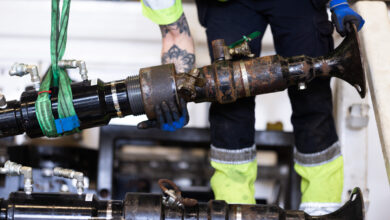Linking personnel wellness to HSE: A healthier workforce is a safer workforce
By Linda Hsieh, managing editor

Whereas responsibilities for employee safety and employee health within a drilling company typically fall to separate departments – generally the HSE department for the former and HR for the latter – those two silos can and should work together more synergistically, Dr Oscar Boultinghouse, VP for NuPhysicia, said. “What goes on in the HR silo can directly impact what we do in the HSE world,” he explained last week at the 2014 IADC HSE&T Asia Pacific Conference in Singapore.
NuPhysicia, which provides medical services to distant locations, including offshore rigs, has been working to link individual health to safety as a way to engage rig employees in improving their health and wellness. “How do you get someone to think about why it’s not only important to me personally, but it’s important to what I do – it allows me to perform at a higher level and in a safer environment?”
As part of a wellness program that the company is implementing in collaboration with Seadrill Americas, NuPhysicia is focusing on what is called metabolic syndrome. “This is where we get down to why it is that blood pressure management or weight, etc, impacts the safety side of the house,” Dr Boultinghouse said.
A person has metabolic syndrome if he or she fits three of the following criteria: central obesity (large waist size); elevated blood pressure; low HDL (good cholesterol), high triglycerides (a blood fat that stores unused calories from the diet); and elevated blood sugar. “If you look at the US population in general, 25% of adults have this issue,” he said.
Studies on metabolic syndrome have traditionally focused on the older population – what are the potential health results if it is left untreated for decades. Some of the associated concerns include twofold risks of cardiovascular disease, heart attack and stroke and fivefold risks of Type 2 diabetes.
“In the last five years, we’ve begun to look at the impact of metabolic syndrome and what it’s doing currently to the person that is untreated. What we’re finding is that we have decreased rate of data acquisition, the ability to respond and analyze. Alertness and cognition are affected, and this is particularly amplified under increasing physiological load,” Dr Boultinghouse said.
“Physiological load is not expending 5,000 calories in a shift on the drill floor. It can be somebody sitting in a cyber chair,” he continued, explaining that it’s something that affects an individual’s ability to think and make decisions. Through the program with Seadrill, NuPhysicia is trying to help individuals who have to make decisions onboard the rig improve their ability to make those decisions. The efforts, which include physician-conducted health risk assessments and goal-setting, aim to “improve the health of what’s going on in between his ears and allow him to make better decisions, allow him to put fewer holes in the Swiss cheese and understand how a healthier workforce is a safer workforce.”
If employees are serious about their health and wellness, then they must make a whole-life commitment, he added. “In other words, you can’t be unhealthy at work offshore and try to be healthy at home, and vice versa… It’s got to be a holistic approach.”
Further, when engaging with individuals on health and wellness issues, it’s important to set reasonable goals. “If you say to an individual that’s 30 lbs overweight, ‘I want you to lose 30 lbs,’ we’re not going to get there. If you say to that individual, ‘In 60 days I want to weigh you again, and I want you to weigh exactly the same as you weigh today’ … If we can start to accomplish that, we can find a balance. At that point, we can begin to work on trimming this or trimming that and having that long, slow path into a reasonable weight loss.”
Reasonable goal-setting is also important when it comes to exercising. “One of the things we’ve done incorrectly in the past is set the standards too high for how much exercise you need to get. I don’t care if you work out 30 minutes five days a week, or if you make the commitment to walk two extra flights of stairs three times a week. Every bit matters. If I can engage you to do that, we have a victory.”
For the wellness program being implemented with Seadrill, Dr Boultinghouse said it’s too early to tell if it has helped to improve the safety record of the rig. There are too many factors – such as changes in the crew composition – that can’t be controlled. “Whether or not I can say I have fewer lost-time accidents on this location because of this program, I can’t. But if I can say we believe that we can improve the level of alertness, without an energy drink, in people with metabolic syndrome by 8-10%, I think everybody would see benefit in that.”




